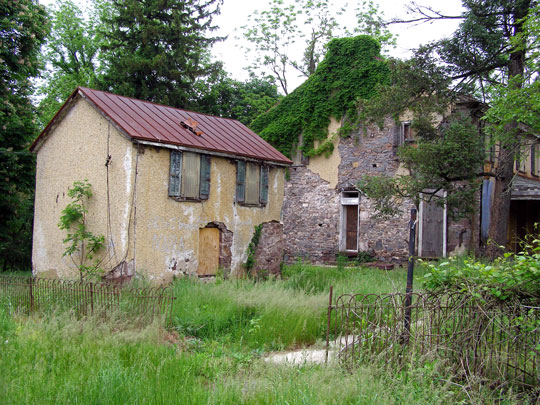The Philadelphia area played an important part in the Industrial Revolution. Pennsylvania was the only one of the original 13 colonies that had the critical resources — coal, iron ore, lumber and petroleum — in abundance. During the early years of our industrial development, canals were important as a means of moving raw materials and finished goods to areas of commerce. Because heavy loads could be moved much more easily on waterways than by horse or wagon, canals were developed around the nation. By 1840, more than 3,000 miles of canals linked bustling areas of business to distant markets. One of these canals ran for over 100 miles from the coal mining regions to the northwest towards the port of Philadelphia. A farmer who lived in northeastern Chester County allowed the construction of two locks on his property, completing a critical portion of this transportation artery.
The story begins in 1733 when Johannes “Hans” Grumbacher came to America. He purchased land in East Coventry Township the next year. One of Grumbacher’s descendants married John Frick, the farmer who permitted his land to be utilized for commercial purposes. The Schuylkill Canal began operation in 1825; locks 54 and 55 passed through Frick’s farmland, allowing hundreds of barges to pass through. Due to the bustling business activity, Frick’s Lock village developed around the canal. The oldest house in the village dates back to 1757, as Great Britain was waging the Seven Years’ War against the French and local Indian tribes in North America. More than a dozen other houses were built as people settled in the area over the ensuing decades. The genealogy of the settler’s families and history of the area is discussed in “The History of Frick’s Locks” by Paul Sumner Frick.
The Canal’s peak operating years were between 1830- 1860, but a rival was gaining attention as a means of transportation. By 1841 the Schuylkill Navigation was annually transporting over 737,517 tons of cargo. In that same year, the Philadelphia and Reading Railroad was completed as a competing means of transporting coal from the Schuylkill anthracite fields to Philadelphia. A rivalry between these two forms of transportation soon developed. Surrendering to the competition in 1870, the Schuylkill Navigation Company leased its waterway to the railroad for a period of 110 years. Under P&R's control, the barge traffic continued to decline. Since the bustling Delaware and Raritan Canal was owned by the competing Pennsylvania Railroad, Schuylkill Canal boats were denied access to this important nearby waterway. As a result, traffic on the Schuylkill Canal decreased rapidly. The PRR itself invaded the Schuylkill's territory with the construction of its Schuylkill Branch in the mid 1880s. Railroads became dominant in the transportation of raw materials and other goods by the late 1800s and canal traffic started to decline. The last barge floated down the canal around 1930, when it was closed to traffic. In 2003, Frick’s Lock was placed on the National Register of Historic Places.
When the Philadelphia Electric Co. began planning to build a nuclear power plant along the Schuylkill in the early 1970s, they knew they would need an “exclusion area” for safety around the plant. PECO contacted landowners in Frick’s Lock for purchase of their properties. By 1980, the last residents had left the area to allow the construction of the power plant. Yet managers at PECO (and later Exelon, the new parent company) realized that the town had historic significance and wanted to preserve the structures in the area. A committee was formed for this purpose that included personnel from the Township Historical Commission, Exelon, Chester County Parks and Recreation, the Schuylkill River Heritage Authority and local government. Exelon earmarked $2.3 million for the restoration and preservation of several of the historic homes in the village. On May 10, 2013 representatives from Exelon and East Coventry Township along with U.S. Representative Jim Gerlach and state Senator Andy Dinniman met for an historic re-dedication of the newly restored village. The ceremony was especially touching, as Larry Frick (son of Paul Sumner Frick) described how his father loved the rich heritage of the area and wanted to attend, but was unable due to his declining health.
Due to rapid economic development, many of America’s historic landmarks are falling by the wayside. Once lost, they’re gone forever. Yet the Frick’s Lock project is one good example of how business can thrive and help preserve our heritage. Exelon is to be commended for its generous contribution to restoring this important part of our local history, now available for public tours. The coal barges no longer float by, but the village may yet receive a large influx of visitors. The Schuylkill River Trail is also expected to be completed in the near future, running alongside the property, bringing casual hikers and perhaps even a few history buffs right by the locks which once helped build the foundations of the country we now call home.
* Gene Pisasale is an author and lecturer based in Kennett Square. He’s written five books, including “Abandoned Address- The Secret of Frick’s Lock”, which focuses on the history of the village and some of the greatest inventors of the Industrial Revolution. His website is www.GenePisasale.com. Gene can be reached at Gene@GenePisasale.com.
About Gene Pisasale
Gene Pisasale is an historian, author and lecturer based in Kennett Square, Pa. His eight books and historic lecture series focus on the history of the mid-Atlantic region. Gene’s latest book is Alexander Hamilton: Architect of the American Financial System, which delves into the life and many accomplishments of this important Founding Father who almost single-handedly transformed our nation from a bankrupt entity into the most successful country in the history of mankind. Gene’s books are available on www.Amazon.com. His website is www.GenePisasale.com; he can be reached at Gene@GenePisasale.com.



Comments